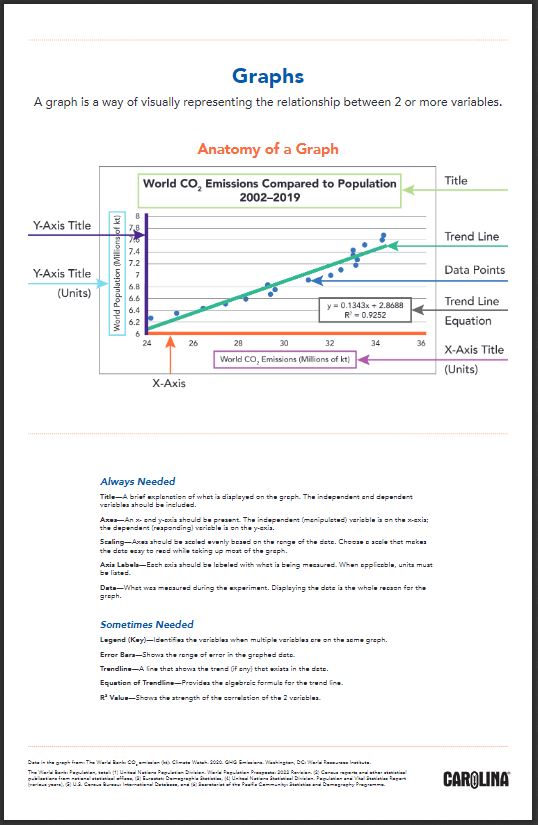Help your students brush up on their graphing skills with this quick review.
Graphs and charts communicate information visually. They can show patterns, help scientists identify correlations, and get the point of the experiment across quickly.
-
- Typically, the independent variable is plotted on the x-axis
-
- The dependent variable is plotted on the y-axis.
The mnemonic DRY MIX, for “dependent, responding, y-axis” and “manipulated, independent, x-axis,” can help students remember this point.
Let’s look at the different types of graphs and which types of data are best represented by each.
Types of Graphs
Different types of data require different types of graphs. Read on to learn about several types.
Line graph
Line graphs show continuous data over periods of time. Before setting up a line graph, determine the dependent and independent variables. The independent variable may be a scalar (numeric) or ordinal (order) quantity. The independent variable always goes on the x-axis. If an experiment requires taking data points every 5 seconds for a minute, or every day for a month, it is appropriate to use a line graph.
Line graphs are similar to x-y scatter plots, except that the individual data points are connected. These graphs may be useful in circumstances when the change from point to point is of interest (as in a titration curve or absorbance spectrum). See the example below of a line graph showing the distance an object traveled from its starting point over time.

X-Y (scatter) plot
A scatter plot is often used to show relationships between independent and dependent variables. Instead of connected data points with a line, a best-fit line can be used to find a trend in data. Scatter plots are frequently used for creating a standard curve in chemistry, as is shown in the graph below. An equation for the trend line can be determined.

Area graph
Similar to a line graph, an area graph is used to track changes over time for one or more groups. An area chart works well for data that both changes over time and indicates where the sum and the parts are important.

Pie chart
Use pie charts to compare parts of a whole. They depict a single point in time rather than changes over time. A pie chart can display percent composition, such as the composition of air. The area of each sector is proportional to a percentage.

Bar graph
Bar graphs are used to compare different groups or to track a change over a period of time. Bar graphs compare data that do not continuously change over time, and they are helpful when you need to compare information collected by counting. A bar graph should be used if you are not looking for trends over time and when the items are not part of a whole. Bar graphs can also be used to compare values from different trials or different experimental groups, and they are ideal when the independent variable is not numerical.








5 Comments
the graph 2nd poster with the graph types does not have a link
Thank you for letting us know! We have fixed this error.
Nice resource! The only modification I would make is to mention that a graph title might be replaced by a figure caption.
It was great resources but i will like to learn more about the graphing
You may find this article helpful: Gathering, Visualizing and Interpreting Data Thank you for the feedback, we are working on building more helpful resources.